The Insider Threat Protection Market is estimated to be valued at USD 5711.0 million in 2025 and is projected to reach USD 30144.7 million by 2035, registering a compound annual growth rate (CAGR) of 17.7% over the forecast period.
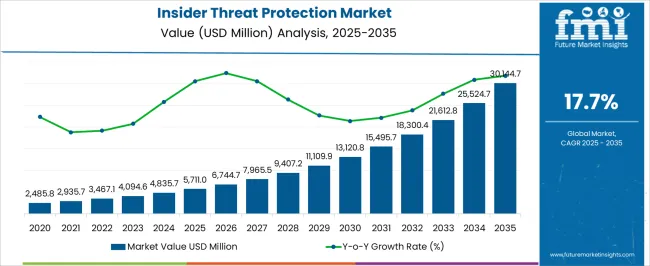
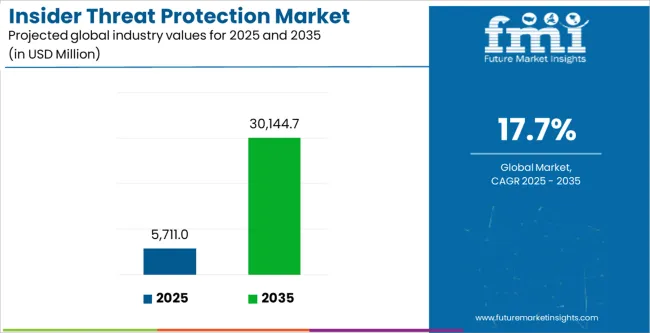
| Metric | Value |
|---|---|
| Insider Threat Protection Market Estimated Value in (2025 E) | USD 5711.0 million |
| Insider Threat Protection Market Forecast Value in (2035 F) | USD 30144.7 million |
| Forecast CAGR (2025 to 2035) | 17.7% |
The insider threat protection market is witnessing significant growth as organizations increasingly recognize the risks posed by internal actors, whether intentional or accidental. Rising data breaches, growing digitization, and stricter compliance mandates have made proactive insider risk management a priority.
The market is shaped by a surge in cloud adoption, remote working, and hybrid workforce structures, which have expanded potential entry points for insider threats. Organizations are adopting integrated security solutions that combine behavioral analytics, identity management, and endpoint protection to mitigate risks.
The future outlook remains positive, supported by increasing regulatory scrutiny and investments in cybersecurity frameworks. As enterprises prioritize securing intellectual property, sensitive customer information, and critical infrastructure, demand for scalable, AI-driven insider threat protection solutions will continue to strengthen globally.
The software segment leads the solution category with approximately 52.40% share, driven by its capability to provide real-time monitoring, behavioral analysis, and automated response mechanisms. Software platforms enable organizations to detect anomalies in user activities, reducing the risk of data leaks and system misuse.
Cloud-native and AI-powered solutions have further reinforced adoption, offering scalability and advanced analytics. The segment benefits from rising enterprise reliance on centralized platforms that integrate with existing cybersecurity frameworks.
With increasing sophistication of insider threats and the need for predictive threat intelligence, software solutions are expected to maintain their leadership in the market.
The professional services segment accounts for approximately 18.30% share in the services category, supported by enterprises seeking expert guidance for risk assessment, implementation, and compliance alignment. Professional services play a crucial role in customizing insider threat protection frameworks according to organizational needs and regulatory landscapes.
Service providers deliver consulting, training, and forensic investigation, ensuring optimized deployment and efficient incident response. The demand is reinforced by the growing complexity of IT environments and the shortage of skilled cybersecurity professionals.
As insider threats become more nuanced, reliance on professional services is expected to rise steadily.
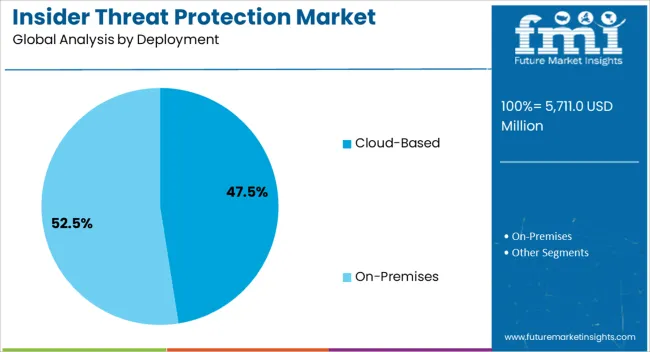
The cloud-based segment represents approximately 47.50% share in the deployment category, reflecting the shift toward scalable, flexible, and cost-efficient security solutions. Enterprises are adopting cloud deployment models to ensure continuous monitoring of distributed and remote workforces.
The segment’s growth is reinforced by reduced infrastructure costs, faster implementation timelines, and the ability to update security features seamlessly. Cloud-based platforms also offer integration with advanced analytics and cross-platform visibility, enhancing detection accuracy.
With hybrid working models becoming permanent and enterprises prioritizing agility, cloud-based deployment is projected to retain its dominant share in the forecast period.
The insider threat protection market underwent a noteworthy transformation from 2020 to 2025, witnessing a substantial increase in market value. In 2020, the market stood at USD 1,993.1 million.
From 2020 to 2025, organizations globally have become more aware of the risks associated with insider threats, leading to a growing demand for insider threat protection solutions. Implementing and enforcing data protection regulations, such as GDPR, have driven organizations to invest in solutions to ensure compliance and protect sensitive information.
The evolving nature of cyber threats and the adoption of advanced technologies have influenced the demand for more sophisticated insider threat protection solutions. The surge in remote work during the COVID-19 pandemic has heightened the need for solutions to address insider threats in distributed and virtual work environments.
Companies began creating official insider threat policies and strategies to deal with workers' careless and malevolent behavior. These programs frequently included user activity monitoring, background checks, and personnel training.
The global insider threat protection market is expected to rise at a CAGR of 18.1% from 2025 to 2035. The market size is expected to reach USD 21,401.9 million by 2035.
The insider threat protection market appears promising, driven by a dynamic cybersecurity landscape and growing awareness of the potential hazards posed by individuals within companies. As companies prioritize data security and privacy, the demand for advanced insider threat prevention solutions is expected to surge.
Artificial intelligence, machine learning, and behavioral analytics are likely to play a vital role in strengthening the capabilities of insider threat defense methods. The global expansion of the insider threat protection ecosystem is also anticipated, further underlining its significance in the evolving landscape of business technology solutions.
The table presents the expected CAGR for the insider threat protection market over several semi-annual periods spanning from 2025 to 2035. In the first half (H1) of the decade from 2025 to 2035, the field is estimated to surge at a CAGR of 16.0%, followed by a slightly higher growth rate of 16.4% in the second half (H2) of the same decade. Moving into the subsequent period, from H1 2025 to H2 2035, the CAGR is projected to remain high at 18.1% in the first half and surge to 18.5% in the second half.
Semi-annual Insights
| Particular | Value CAGR |
|---|---|
| H1(2020 to 2024) | 16.0% |
| H2(2020 to 2024) | 16.4% |
| H1(2025 to 2035) | 18.1% |
| H2(2025 to 2035) | 18.5% |
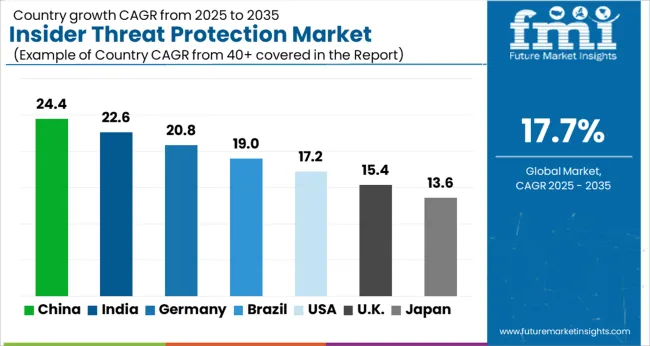
The table below shows the estimated growth rates of the top five countries. China, Japan, and Germany are set to record high CAGRs of 24.8%, 22.5%, and 19.7%, respectively, through 2035.
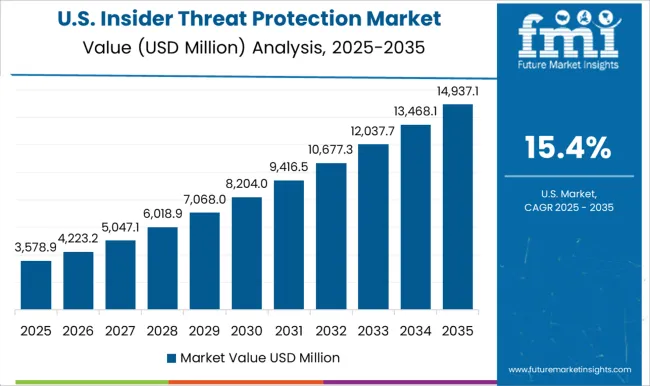
The insider threat protection market in the United States is set to rise at a CAGR of 19.0% from 2025 to 2035. The main factors supporting the market’s growth are:
Japan’s insider threat protection market is estimated to rise at a CAGR of 22.5% over the forecast period. Top factors supporting the market’s expansion in the country include:
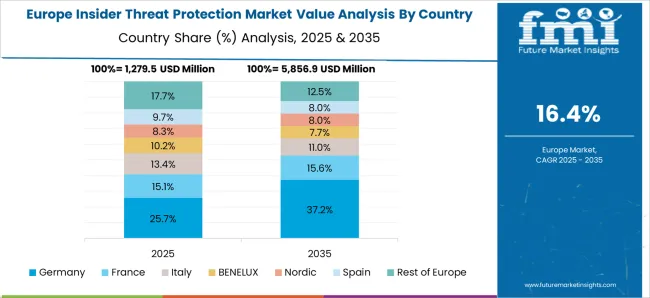
The insider threat protection market in Germany is estimated to record a CAGR of 19.7% through 2035. The primary factors bolstering the market size are:
India is estimated to rise at a CAGR of 21.2%. Key factors influencing the market include:
Key players are significantly investing in China, as the country is offering greater growth opportunities than its counterparts. Through 2035, China is projected to expand at a CAGR of 24.8%, driven by the following factors:
The section below shows the service segment dominating by solution. It is predicted to surge at a CAGR of 19.1% by 2035. Based on deployment type, the cloud-based segment is anticipated to generate a dominant share through 2035. It is set to rise at a CAGR of 19.7% by 2035.
| By Solution | Value CAGR |
|---|---|
| Software | 16.8% |
| Services | 19.1% |
The services segment experiences a surge in demand as organizations grapple with increasingly sophisticated and complex insider threats. Security professionals offer specialized expertise in navigating intricate threat landscapes and implementing effective countermeasures.
The dynamic nature of cyber threats necessitates continuous adaptation in the service segment. Security professionals within the professional service segment are adept at staying ahead of emerging threats, providing organizations with proactive measures to counter evolving insider threat tactics.
| Deployment Type | Value CAGR |
|---|---|
| Cloud-based | 19.7% |
| On-premises | 15.9% |
As industries use the benefits of cloud computing, organizations face new hurdles in protecting sensitive data from insider threats. Cloud-based insider threat protection services provide a cutting-edge approach to digital asset security and strong protection against potential breaches & illegal access.
Cloud-based solutions also offer real-time monitoring of user activity and data access, allowing for the rapid identification of considered actions. Products and services enable continuous analysis, generating alarms for potential insider threats, using advanced analytics and machine learning algorithms. This proactive approach enables prompt intervention and mitigation.
| Enterprise Size | Value CAGR |
|---|---|
| SMEs | 19.6% |
| Large Enterprises | 16.7% |
For SMEs, customized solutions, scalable technologies, and a strategic focus on the organization's unique characteristics are essential for effective protection. As SMEs evolve, their insider threat defense strategies also evolve in tandem, ensuring a resilient and adaptable security posture.
Insider threat protection service providers offer customized solutions to meet the specific demands of each enterprise. This entails easily integrating the technology into existing security frameworks and IT systems.
The ever-changing nature of cyber threats necessitates scalable and adaptable solutions. Service providers offer scalability to allow an organization's growth and respond to shifting threat scenarios. This ensures that solutions for insider threat protection remain effective and relevant.
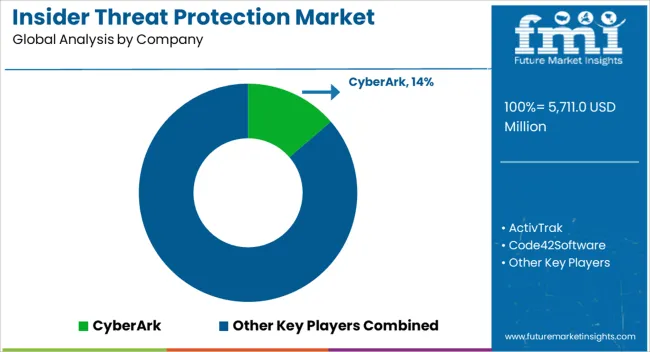
Key players are focusing on improving the customer experience for their insider threat protection solutions. They also consider the different needs and requirements of end-users and tailor solutions to their needs. Leading companies in the insider threat prevention market use a range of inorganic growth strategies, including alliances, mergers, and acquisitions, to increase the scope of their product offerings.
Key Developments
The global insider threat protection market is estimated to be valued at USD 5,711.0 million in 2025.
The market size for the insider threat protection market is projected to reach USD 30,144.7 million by 2035.
The insider threat protection market is expected to grow at a 17.7% CAGR between 2025 and 2035.
The key product types in insider threat protection market are software, _user and entity behavior analytics (ueba), _security information and event management (siem), _identity and access management (iam) and _others.
In terms of services, _professional services segment to command 18.3% share in the insider threat protection market in 2025.






Full Research Suite comprises of:
Market outlook & trends analysis
Interviews & case studies
Strategic recommendations
Vendor profiles & capabilities analysis
5-year forecasts
8 regions and 60+ country-level data splits
Market segment data splits
12 months of continuous data updates
DELIVERED AS:
PDF EXCEL ONLINE
Insider Risk Management Market Size and Share Forecast Outlook 2025 to 2035
Threat Hunting Market Size and Share Forecast Outlook 2025 to 2035
Threat Intelligence Market Trends – Growth & Forecast 2024-2034
Threat Detection Systems Market
Mobile Threat Management Security Software Market Size and Share Forecast Outlook 2025 to 2035
Specialized Threat Analysis And Protection Market
Advanced Persistent Threat Protection Market
Flu Protection Kits Market Size and Share Forecast Outlook 2025 to 2035
Eye Protection Equipment Market Size and Share Forecast Outlook 2025 to 2035
Teleprotection Market Growth – Trends & Forecast 2025 to 2035
ESD Protection Devices Market Insights – Trends & Demand 2023-2033
Fire Protection Materials Market Size and Share Forecast Outlook 2025 to 2035
Fall Protection Market Size and Share Forecast Outlook 2025 to 2035
CBRN Protection Equipment Market Size and Share Forecast Outlook 2025 to 2035
Fire Protection System Pipes Market Size and Share Forecast Outlook 2025 to 2035
DDoS Protection Market Size and Share Forecast Outlook 2025 to 2035
Fire Protection Systems for Industrial Cooking Market Growth - Trends & Forecast 2025 to 2035
DDoS Protection & Mitigation Security Market Growth - Trends & Forecast through 2034
Head Protection Equipment Market Growth – Trends & Forecast 2024-2034
Data Protection as a Service (DPaaS) Market

Thank you!
You will receive an email from our Business Development Manager. Please be sure to check your SPAM/JUNK folder too.
Chat With
MaRIA